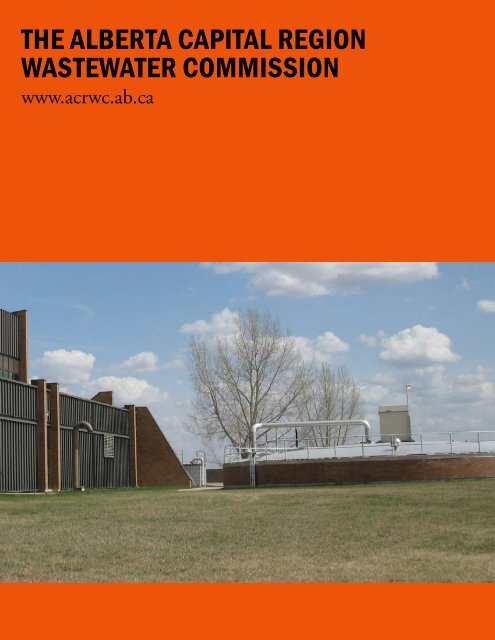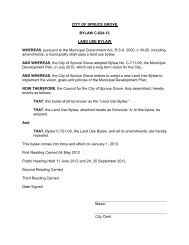the alberta capital region wastewater commission - Agenda
the alberta capital region wastewater commission - Agenda
the alberta capital region wastewater commission - Agenda
Create successful ePaper yourself
Turn your PDF publications into a flip-book with our unique Google optimized e-Paper software.
The Alberta Capital RegionWastewater Commissionwww.acrwc.ab.ca
2 WASTEWATER The Alberta Capital Region Wastewater Commission02Alberta Capital RWastewater Co
The Alberta Capital Region WastewaterCommission (ACRWC) is a model of<strong>region</strong>al cooperation providing service to 13municipalities in <strong>the</strong> Alberta Capital Region.Formed in 1985, in response to growth in <strong>the</strong><strong>region</strong> at <strong>the</strong> time, <strong>the</strong> Commission was andis governed by <strong>the</strong> Municipal GovernmentAct with a mandate to provide safe, reliable,cost-efficient and environmentally responsible<strong>wastewater</strong> service. Today, <strong>the</strong> ACRWC servesover 200,000 residents.
6 WASTEWATER The Alberta Capital Region Wastewater CommissionMike Darbyshire, general manager, describesit in <strong>the</strong> simplest terms: “The ACRWC deals withtransmission and treatment of <strong>wastewater</strong>, that’swhat we do. Each community connected to <strong>the</strong>system collects its own <strong>wastewater</strong> and dischargesit into <strong>the</strong> system. Then we take it andbring <strong>the</strong> water to <strong>the</strong> plant and treat it, beforedischarging it to <strong>the</strong> North Saskatchewan River.”How it all worksThe transmission system consists of 120 km ofgravity sewers, 51 km of pressure pipelines andfive pump stations. This system conveys <strong>wastewater</strong>to <strong>the</strong> ACRW Treatment Plant from membermunicipalities in <strong>the</strong> west, north and east sectionsof <strong>the</strong> <strong>region</strong>. It also conveys <strong>wastewater</strong>from <strong>the</strong> south members (City and County ofLeduc, and <strong>the</strong> Town of Beaumont) into <strong>the</strong> Cityof Edmonton system for treatment.In exchange, <strong>the</strong> ACRW Treatment Planttakes <strong>wastewater</strong> from Clareview in nor<strong>the</strong>ast Edmontonand from <strong>the</strong> Clover Bar Industrial Area.This exchange is regulated by <strong>the</strong> SWAP Agreementbetween Edmonton and <strong>the</strong> Commission(which expires in 2015).As for <strong>the</strong> treatment, <strong>the</strong> provincial govern-GLOBAL PERSPECTIVE.LOCAL FOCUS.
MAY 2010 The Canadian Business Journal7ment requires <strong>the</strong> plant treatment processes toachieve ammonia-nitrogen concentration to lessthan 10 mg/L during winter months and lessthan 5 mg/L during summer months, and totalphosphorus less than 1.0 mg/L.Darbyshire says this mandate is relativelynew. “We get an operating approval that sets<strong>the</strong> parameters for how well we have to treat<strong>the</strong> <strong>wastewater</strong>,” he explains. “In 1996, <strong>the</strong>government changed it so that, by June 2005,we had to go from conventional treatment toan advanced treatment processes of biologicalnutrient removal (BNR) and ultraviolet (UV) disinfection.We had to start treating for nitrogen andphosphorous before <strong>the</strong> <strong>wastewater</strong> gets dischargedto <strong>the</strong> rivers.”Why it’s importantBecause <strong>wastewater</strong> management doesn’t affecthousehold drinking water, <strong>the</strong>re is room for confusionas to why it’s important. What <strong>the</strong> publicshould understand is that treatment removes orreduces contaminants in <strong>the</strong> water, so that <strong>the</strong>treated effluent from will not create pollution towater body after it is discharged.If <strong>wastewater</strong> goes untreated, <strong>the</strong> organicmatter it contains will decompose and leadto nuisance conditions, such as production ofmalodorous gases. It also contains nutrients thatYOU CAN HELP ▼You can help• Conserve water in your home by usinglow-flow fixtures and fix any leaks. Thisreduces <strong>the</strong> amount of water that needsto be treated.• Don’t pour fats, oils and grease down<strong>the</strong> drain–dispose in <strong>the</strong> garbage. Thesesubstances clog pipes leading to costlyrepairs.• Take unused medications to <strong>the</strong>pharmacy for disposal ra<strong>the</strong>r thanflushing <strong>the</strong>m down <strong>the</strong> toilet.Pharmaceuticals are not treated and endup in <strong>the</strong> environment.• Use phosphate-free cleaning materialsto reduce phosphorous levels in <strong>the</strong>river. Phosphorous is a nutrient thatpromotes algae growth negativelyaffecting <strong>the</strong> aquatic environment.• Take household hazardous waste –motoroil, pesticides, herbicides, solvents,paint and chemicals –to a recycle facilityor community round-up event insteadof pouring it down <strong>the</strong> drain. Toxicsubstances are not treated and end up in<strong>the</strong> environment.• Compost organic materials likevegetable peelings instead of using agarburator. Ground up organic materialcosts more to treat and must be disposedof at <strong>the</strong> <strong>wastewater</strong> treatment plant.
8 WASTEWATER The Alberta Capital Region Wastewater Commission
MAY 2010 The Canadian Business Journal9The Alberta Capital Region Wastewater Commissionwill continue to maintain <strong>wastewater</strong> qualitywell into <strong>the</strong> future. In fact, <strong>the</strong> Commissionhas a major project out for tender to increase<strong>the</strong> capacity of part of <strong>the</strong> plant; it is also buildinga new pump station in <strong>the</strong> City of St. Albert.“The expansions are mainly to meet <strong>the</strong> needs ofgrowth,” says Darbyshire. “We’re developing anasset management plan, to expand and to repair.After 25 years, some of <strong>the</strong> infrastructure wearsdown. We’re maturing to <strong>the</strong> point of developingreplacement programs. There will always be improvements.In <strong>the</strong> next decade, <strong>the</strong>re could bemore stringent water requirements in treatmentthat may require an extra process.”“One o<strong>the</strong>r program we have initiated in<strong>the</strong> last year is a source control program, whichcan stimulate <strong>the</strong> growth of aquatic plants andmay contain toxic compounds or compounds thatpotentially may be mutagenic or carcinogenic. Ifthis water is ingested, it can cause a lot of problemsfor animal and human populations. For<strong>the</strong>se reasons, to protect public health and <strong>the</strong>environment, <strong>the</strong> <strong>wastewater</strong> should be treatedto remove <strong>the</strong> nuisances/contaminants so thatit can be reused or discharged into <strong>the</strong> environment(water bodies such as a river or a lake).Continuing to meet needstargets <strong>the</strong> industrial/commercial sector,” Darbyshireadds. “It’s an area that we’re working onwith our members, talking with industries andgetting out <strong>the</strong>re to do site samples. The programis to promote responsible <strong>wastewater</strong> practices.”Although <strong>the</strong> ACRWC will remain committedto its mandate, it’s not only up to <strong>the</strong> Commissionto ensure our safety and health. There are severalthings <strong>the</strong> public can do to help within our homes(see sidebar). Toge<strong>the</strong>r, we can all participate inhelping <strong>the</strong> environment and our future. CB
AS SEEN IN THE MAY 2010 ISSUEOF THE CANADIAN BUSINESS JOURNAL
‣ Bylaw No. 8 governing <strong>the</strong> quality of <strong>wastewater</strong> accepted by <strong>the</strong> Alberta Capital RegionWastewater Commission was adopted. This new by-law will form <strong>the</strong> core of ourmember municipalities’ sewer bylaws and is in integral part of <strong>the</strong> Commission’s sourcecontrol program.‣ The construction contract for <strong>the</strong> new DAF Facility 2 was awarded to Sure-FormConstruction Ltd. This facility is used to thicken waste activated sludge from <strong>the</strong>bioreactors before it is transferred to <strong>the</strong> digesters, reducing biosolids handling costs.‣ Board Members and Senior Managers attended a successful and fruitful StrategicPlanning Workshop in May.‣ Next Board Meeting – July 16, 2010‣ Performance Management Committee Meeting – June 18, 2010‣ MARK YOUR CALENDAR – Member Municipal Councils and StaffEvent:Date:Time:Location:RSVPBBQ and Plant ToursThursday, June 24 th11:00 a.m. – 2:00 p.m.Alberta Capital Region Wastewater Treatment Plant23261 Township Road 540Fort Saskatchewan, ABby June 14 th toCarolyn Low<strong>the</strong>r780 467-8655E-mail: clow<strong>the</strong>r@acrwc.ab.caFor more information –Alberta Capital Region Wastewater CommissionPhone: 467-8655 Fax: 467-5398 Web site: www.acrwc.ab.caMike Darbyshire, General Managermdarbyshire@acrwc.ab.caBrad Willard, Manager of Operationsbwillard@acrwc.ab.caGil Carleton, Manager of Engineeringgcarleton@acrwc.ab.caPaul Krueger, Finance Managerpkrueger@acrwc.ab.ca





